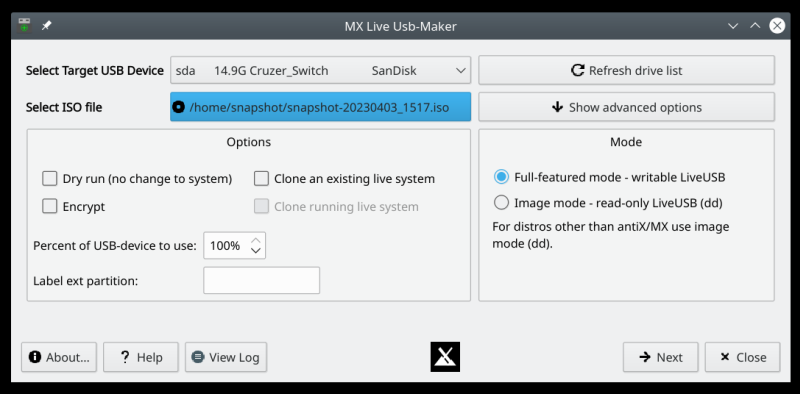Updated: May 10, 2023
MX Linux is a small, Debian-based distro. It comes in Xfce and KDE flavors. It's pretty decent, but there are problems here and there, typical for projects with limited resources and manpower. That said, I've always liked the distro, the approach, and the effort invested in making their operating system nice and practical.
There's one aspect of the system that stands out, and that's the bundle called MX Tools. This fantastic toolbox offers the end user a whole range of features with simple step-by-step wizards, things which are typically done through the command line, in a nerdy way. Today, I want to shed light on MX Snapshot, a utility that lets you create bootable (live) images of your entire system. Backup and imaging rolled into one. Let's.
Create a snapshot
Invoke the tool - either directly through the system menu, or by using MX Tools. Once it's launched, it lets you configure your snapshot. First, you need to select the location where you want to store your created snapshot image. This can be a network drive. You give it a name, and optional tweaks, like custom name, boot options, and such.
Then, on the second screen, you can further customize what goes into your image. This is the best part. You can include or exclude your entire home directory (and thus potentially data). There are some common presets available, but you can also manually check and edit the Exclusion file, which is a handy resource of its own. It's a file that is used by the rsync tool, so you can use it as a reference for your own backups, if you want to.


You can also choose the compression level - how big your image will be, and a checksum, in case you want to give out your remastered versions of the MX Linux distro to other people. Indeed, you can make a personal backup or an anonymized redistributable version, which will not contain any personal account data.
Next, let it run. For me, the process was quite quick. Roughly 8 GB worth of data were ISO-ed in about two minutes, on the not-too-powerful IdeaPad 3 laptop, which does have an okay NVMe drive, and which was used both as a source and target for the image creation. Once you're done, MX Snapshot instructs you to create a bootable version of the ISO file using MX Live USB Maker.


Create live USB
I launched this second utility next. It's an interesting tool in its own right. It has a whole bunch of options, including some that seem a bit weird or redundant if you used MX Snapshot. But you can also dry-run your USB making, to see what would happen, encrypt the system, decide how much space you want to allocate on your external device (potentially an entire hard disk, which you want to use for various purposes), and select between read-only or writable USB. The latter is somewhat similar to Puppy Linux, where you can have live media with persistence. Very handy, as this gives you an excellent system troubleshooting tool for any use, but you can also use it to store and retain personal data until the moment you're ready to commit the USB media to a system somewhere.

The process here was slower (depends on the size and USB stick speed), but done successfully:

Test your new live media
I booted the USB stick on the IdeaPad. Indeed, it launched into a live session, but one that has all of my customization and my personal data in place. Essentially, a redistributable version of my own system, an image, a backup, and a portable Linux toolbox, all in one. I took a screenshot that should illustrate what I've done. Notice the desktop, compare to my Wildflower review, but then look at the actual storage devices. We're running from a USB stick, in a live mode, and we CAN now install this to a disk, if we like. Inception plus recursive fun.

Conclusion
Long time ago, I was really happy with remastersys, but then it kind of disappeared. Most Linux distros have similar abilities, but they do not advertise them, or package them in a convenient, user-friendly way. MX Linux does that, and gives you the optimal user experience. You can protect your system, your data, redeploy everything in one quick go, and even test functionality live before going forward. There are tons of options and customization available, so you can really make the best of your redistributable snapshot image. Very nice.
I am quite pleased, I must say. It would be nice to see some extra features, of course. For instance, how does local LUKS encryption come into play, if at all? What about proprietary drivers and redeployment on new hardware? Finally, can MX Snapshot and such be used on other distros? Is it possible to make it available to the wider range of Linux users? It would be nice if I could just grab the tools, install them on any which distro without any great hax0ring, and enjoy the amazing flexibility of this program. Anyway, if you like data backups and imaging, here's an application that will satisfy all your wee kinks. MX Snapshot is a great thing in its own right, and also a testament to the clever work done by the MX Linux team. Test and use, you should.
Cheers.